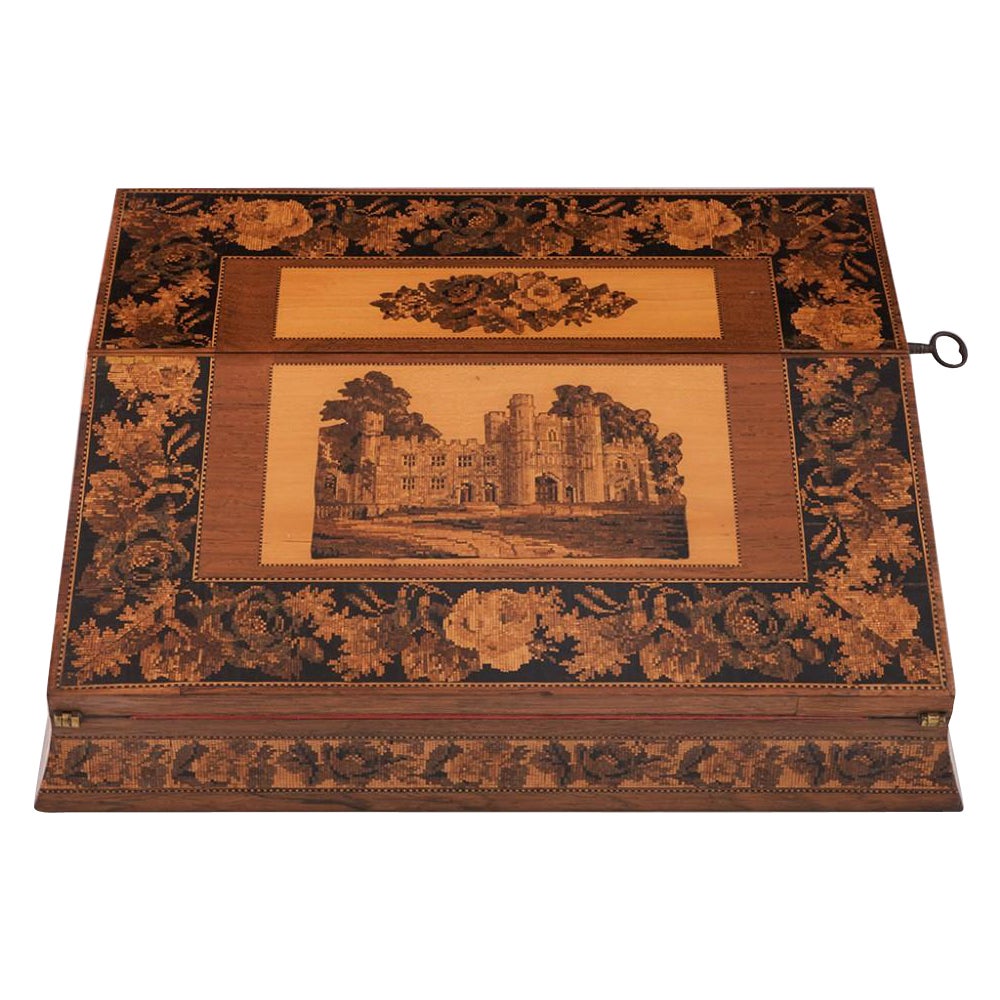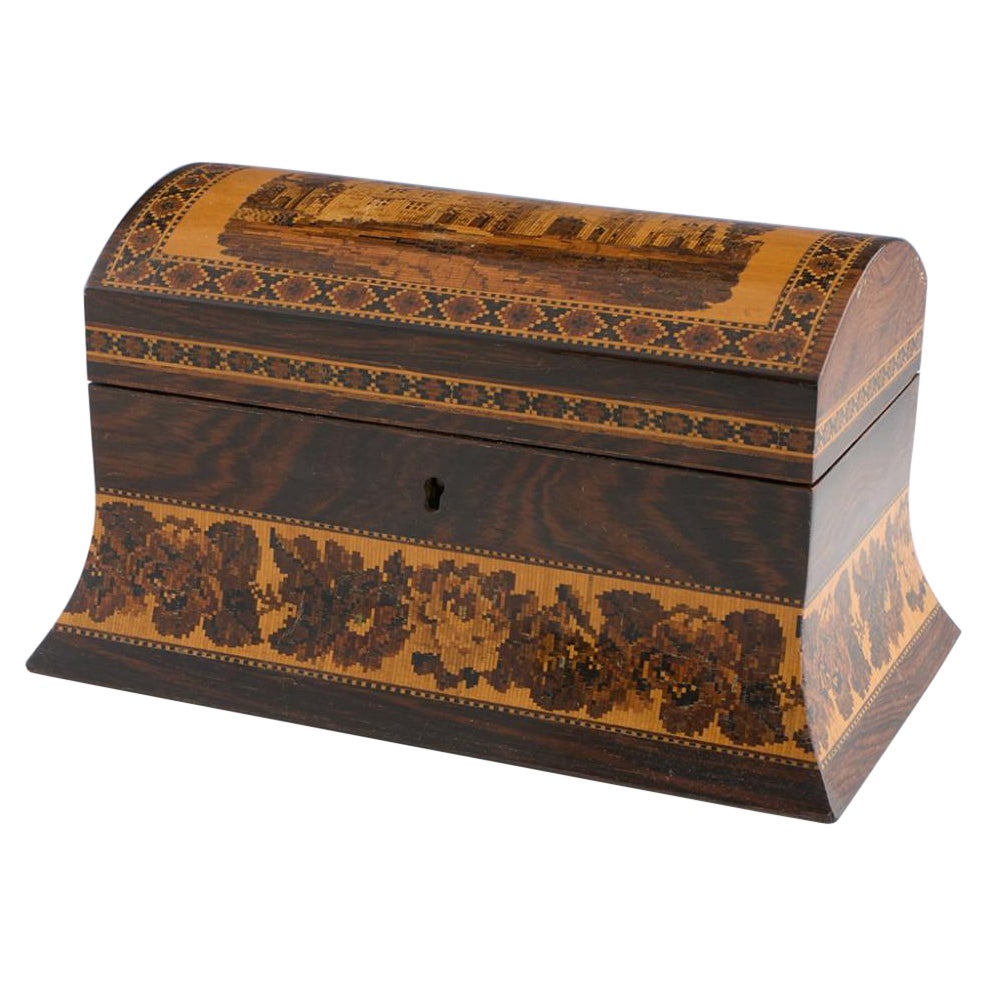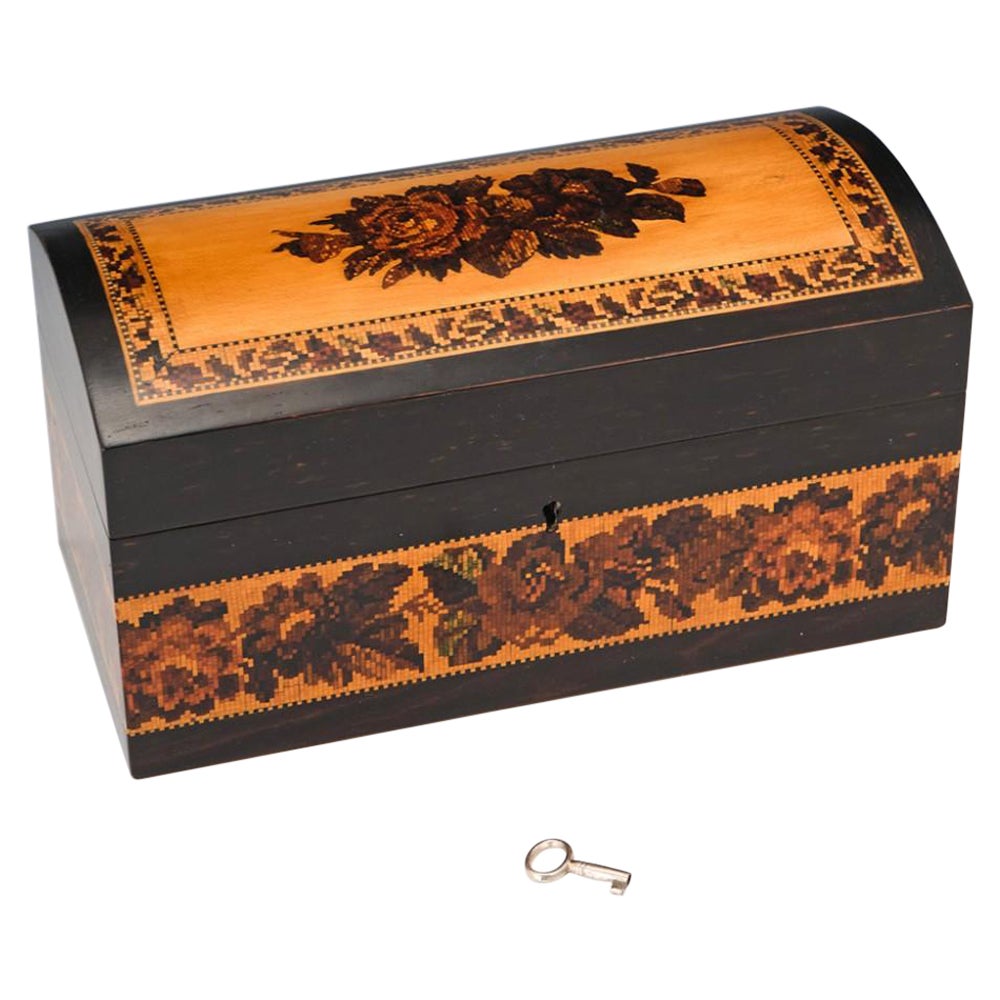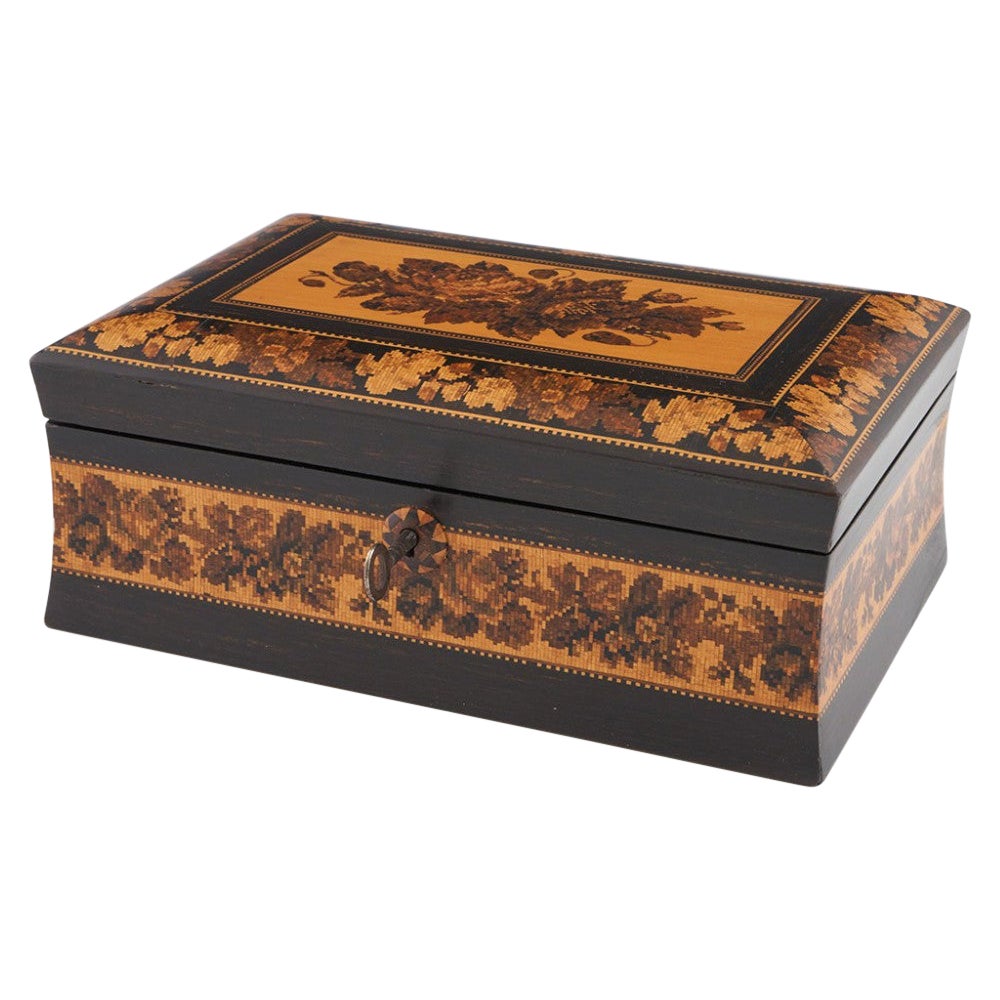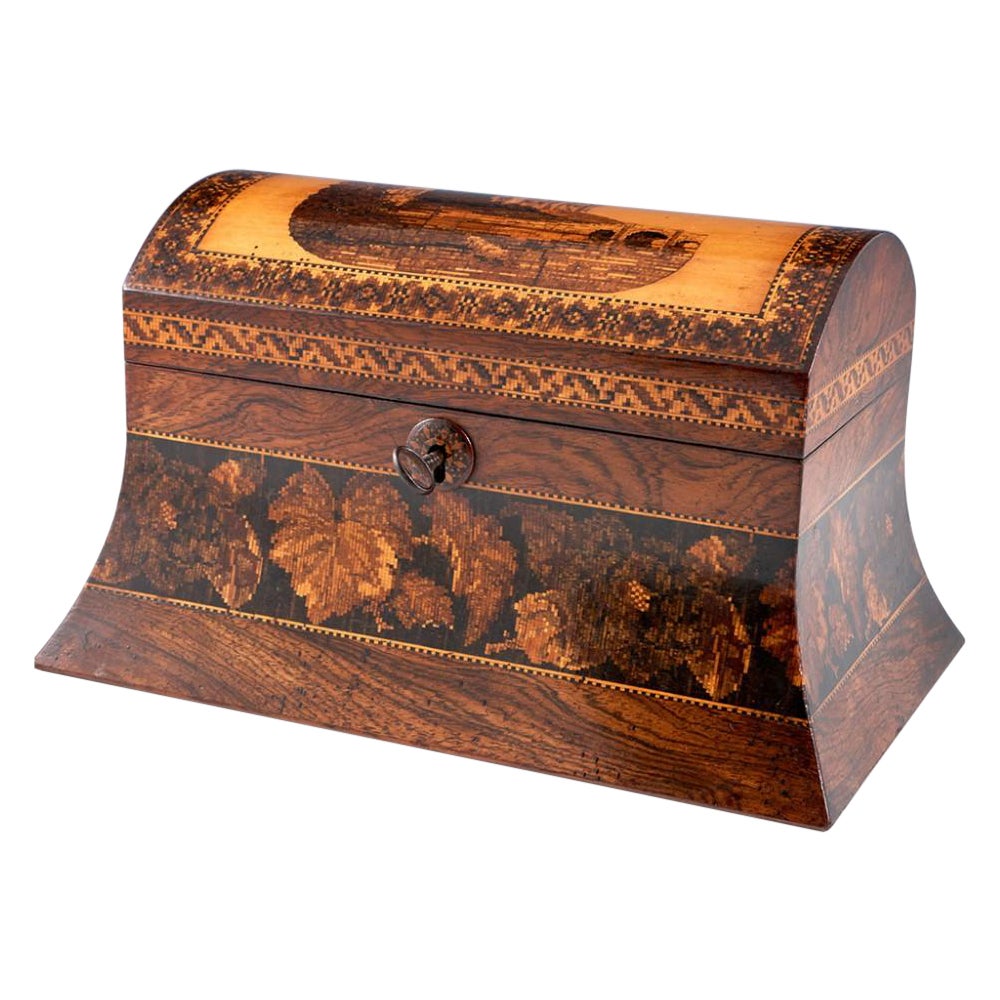Items Similar to Tunbridge Ware Glovebox with Mosaic Depicting Muckross Abbey, c1870
Want more images or videos?
Request additional images or videos from the seller
1 of 9
Tunbridge Ware Glovebox with Mosaic Depicting Muckross Abbey, c1870
About the Item
Tunbridge Ware Glovebox with Mosaic Depicting Muckross Abbey, c1870
Additional Information:
Heading: Tunbridge Ware Glovebox with Mosaic depicting Muckross Abbey
Date : c1870
Period : Victorian
Origin : Tunbridge Wells
Decoration : The rounded, flat-ended lid has an image of Muckross Abbey set with Golden Satinwood, and bounded with banded and continuous keylines; further banded keylines frame a narrow geometric-pattern band; Has an oak-leaf and acorn Berlin Wool-work frieze to all four flat sides within the same banded and continuous keylines. Lined with the original red satin.
Size : 26.5 W x 10.1 D x 9.9 H cm
Condition : Excellent with regard to tile completeness - there are barely half a dozen missing pieces, two or three of which are contiguous; extremely slight bumps and bruises to the edges, entirely commensurate with age; a small, round indentation to one end face and a similarly insignificant ding to the lid.
Restoration : Professionally cleaned and polished
Note : Muckross Abbey, in Ireland, may seem a strange subject for a piece of Tunbridge Ware, but its relevance is two-fold; firstly - as you can see - it is almost the archetypal ruin, with its tower, window tracery, vaults and walls;, in addition to this it is the burial place of four of Ireland's most renowned romantic poets (O'Donoghue, O'Rahilly, Ferriter and O'Sullivan) whose works were enjoying a resurgence in popularity at the time this piece was produced.
- Dimensions:Height: 3.9 in (9.9 cm)Width: 10.44 in (26.5 cm)Depth: 3.98 in (10.1 cm)
- Materials and Techniques:
- Place of Origin:
- Period:
- Date of Manufacture:circa 1870
- Condition:There are barely half a dozen missing pieces, two or three of which are contiguous; extremely slight bumps and bruises to the edges, entirely commensurate with age.
- Seller Location:Tunbridge Wells, GB
- Reference Number:
About the Seller
5.0
Gold Seller
These expertly vetted sellers are highly rated and consistently exceed customer expectations.
Established in 2014
1stDibs seller since 2023
34 sales on 1stDibs
Typical response time: 5 hours
- ShippingRetrieving quote...Ships From: Tunbridge Wells, United Kingdom
- Return PolicyA return for this item may be initiated within 30 days of delivery.
More From This SellerView All
- Tunbridge Ware - A Writing Slope Box Depicting Battle Abbey Gatehouse, c1870By Henry HollambyLocated in Tunbridge Wells, GBTunbridge Ware - A Writing Slope Box Depicting Battle Abbey Gatehouse, c1870 Additional Information: Heading: Tunbridge Ware - A Writing Slope Depicting Bat...Category
Antique 19th Century English Victorian Decorative Boxes
MaterialsWood
- Tunbridge Ware Two Compartment Tea Caddy Depicting Battle Abbey Gatehouse c1870By Henry HollambyLocated in Tunbridge Wells, GBHeading : Tunbridge ware tea caddy depicting battle abbey gatehouse Date : c1870 Period : Victoria Origin : Tunbridge Wells, Kent Decoration : Central image depicts Battle Abbey Gate...Category
Antique 1870s British Victorian Tea Caddies
MaterialsWood
- Tunbridge Ware Stationery Box, c1870Located in Tunbridge Wells, GBTunbridge Ware Stationery Box, c1870 Additional Information: Heading: A superb Tunbridge Ware three division stationery box Date : c1870 Period : Victoria Origin : Tunbridge Wells, ...Category
Antique 19th Century English Victorian Decorative Boxes
MaterialsPaper
- Tunbridge Ware Jewellery Box c1870By Tunbridge WareLocated in Tunbridge Wells, GBHeading : Tunbridge ware jewellery box Date : c1870 Period : Victoria Origin : Tunbridge Wells, Kent Decoration : Pillow top cover with central floral mosaic within keylines. Cover b...Category
Antique 1870s British Victorian Decorative Boxes
MaterialsWood
- Tunbridge Ware Stationery Box with Isometric Cubes and Floral Mosaic, c1870Located in Tunbridge Wells, GBTunbridge Ware Stationery Box with Isometric Cubes and Floral Mosaic, c1870 Additional Information: Heading: Tunbridge Ware - Wedge-Shaped Stationery Box with Isometric Cubes and Fl...Category
Antique 19th Century English Victorian Decorative Boxes
MaterialsPaper
- Tunbridge Ware Tea Caddy Rare Depiction Carew Castle Pembrokeshire, c1870By Henry HollambyLocated in Tunbridge Wells, GBTunbridge Ware Tea Caddy Rare Depiction Carew Castle Pembrokeshire, c1870 Additional Information: Heading: Tunbridge Ware Tea Caddy Rare Depiction Carew Castle (Pembrokeshire) c1870 Date : c1870 Period : Victorian Origin : Tunbridge Wells attributed to Henry Hollamby Decoration : Has a classic floral ""Berlin...Category
Antique 19th Century English Victorian Tea Caddies
MaterialsSatinwood
You May Also Like
- Tunbridge Ware BoxLocated in Dallas, TXLarge Tunbridge ware box with herringbone pattern inlaid parquetry. Circa 1840, England.Category
Antique 1840s English Decorative Boxes
MaterialsWood
- Fine Tunbridge Ware Writing Box / Lap Desk, Eridge Castle, circa 1870Located in Bath, GBA truly fine example of a Victorian Tunbridge Ware writing box or lap desk dating to circa 1870. The central section featuring Eridge Castle, East Sussex. The box comes complete w...Category
Antique 1870s British Late Victorian Decorative Boxes
MaterialsWood
- Regency Tunbridge Ware Sewing BoxBy Tunbridge WareLocated in Northampton, GBFitted Interior & Silver Handles From our Tunbridge Ware collection, we are delighted to offer this Tunbridge Ware Sewing Box. The Sewing Bo...Category
Antique Early 19th Century British Regency Decorative Boxes
MaterialsSatinwood
- Victorian Tunbridge Ware Tea CaddyLocated in Bedfordshire, GBA Charming 19th Century Tunbridge Ware Tea Caddy With Attractive Floral Band To Main Body And Parquetry Perspective Cubes To Hinged Lid Enclosing Lidded Interior. Tea was an extrem...Category
Antique Mid-19th Century English Victorian Tea Caddies
MaterialsOther
- Brighton Pavilion Tunbridge Ware Sewing CompendiumBy Tunbridge WareLocated in Northampton, GBRare Tunbridge Ware Form Sewing Compendium From our Tunbridge Ware collection, we are delighted to offer this very rare Tunbridge Wear Sewing Compendium. The Sewing Compendium modelled as a tower from the Brighton Pavilion features the iconic minaret turned in Sycamore (aka white wood) and a large globular body with hand-painted details leading to further turned faces and the hand-painted windows upon a stepped base. The Sewing Compendium opens in two locations one just below the first dome revealing a pin cushion and the second just above the windows revealing the Sewing tools including a Tunbridge Ware thimble and bobbin. The Tunbridge Ware Sewing Compendium dates to the Georgian era during the reign of George IV circa 1825. Brighton Pavilion, The Royal Pavilion and surrounding gardens are a Grade I listed property and were the former Royal residence located in Brighton, England. It was built in 1787 in three stages as a seaside retreat for George, Prince of Wales who became the Prince Regent in 1811 and then King George IV in 1820. It is built in the Indo-Saracenic style prevalent in India for most of the 19th century. The current appearance of the Pavilion which has various domes and minarets, is the work of architect John Nash, who extended the building starting in 1815. George IV's successors William IV and Victoria also used the Pavilion but Queen Victoria decided that Osborne House should replace the Pavilion as the royal seaside retreat and therefore the Pavilion was sold to the city of Brighton in 1850. Indo-Sarascenic refers to a cross between Indian architecture and Muslim architecture. Minarets means beacon in Arabic. In Islamic religious architecture, the tower from which the faithful are called to prayer five times each day by a muezzin, or crier. Such a tower is connected to a mosque and has one or more balconies or open galleries. The inspiration for the minarets features on the Brighton Pavilion are in homage to these types of finials. John Nash (1752-1835) was one of the most prevalent British architects from the Georgian and Regency periods. He was responsible for the design, in the neoclassical and picturesque styles of many important areas of London. He was financed by the Prince Regent and by the era's most successful property developer, James Burton. Nash's most famous designs were the Brighton Pavilion, Marble Arch and Buckingham Palace. Sycamore is a member of the Maple family, found in Europe. It is light yellow in colour and is often a very clean wood, with a straight, fine grain. The wood is often pippy. However, these pips are usually a very similar colour to the rest of the wood making them hardly visible. Georgian, a period in British history dating from 1714-1837, the Georgian era after the Hanoverian kings George I, George II, George III and George IV. Tunbridge Ware Tunbridge Wells and Tunbridge in Kent, England became popular in the 17th Century for their therapeutic waters. By the 18th century, Tunbridge Wells was a hugely popular Spa resort. Shops and stalls were set up to sell local work of distinction to visitors as souvenirs. Many of the original boxes were decorated with all sorts of different kinds of designs. Many of the Tunbridge boxes...Category
Antique Early 19th Century British George IV Decorative Boxes
MaterialsWood, Sycamore
- Tunbridge Wooden Trinket Box England 1870Located in Stamford, CTTunbridge wooden trinket box made in England in the 1870s. Intricate floral design. Tunbridge wooden trinket box made in England in the 1870s. Tun...Category
Antique 19th Century English Decorative Boxes
MaterialsHarewood
Recently Viewed
View AllMore Ways To Browse
Used Glovebox
French Copper Repousse
Gold Enamel Pill Box
French Empire Porcelain Jewlery Box
Choisy Le Roi Box
Brass Trinket With Coral And Turquoise
Tooth Fairy Boxes
Metal Tissue Box
Regency Writing Box
Hidden Flask
F And B Sterling Hand Mirrors
Maitland Smith Alligator
Roberto Cavalli Corner
Sewing Caddy
Straw Zebra Box
Antique Benedictine Bottle
Antique Dazey Churn
Beaver Silk Top Hat
